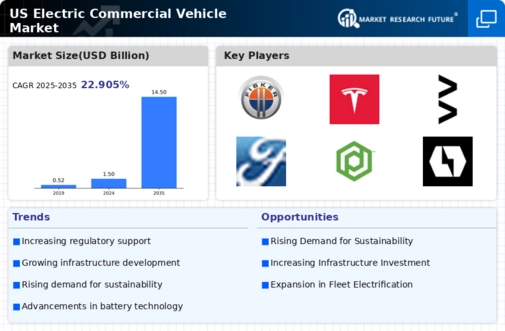The electric commercial-vehicle market is currently characterized by a dynamic competitive landscape, driven by technological advancements, regulatory support, and a growing emphasis on sustainability. Major players such as Tesla (US), Rivian (US), and Nikola (US) are at the forefront, each adopting distinct strategies to enhance their market positioning. Tesla (US) continues to leverage its strong brand equity and innovation in battery technology, while Rivian (US) focuses on its unique electric delivery vans tailored for commercial use. Nikola (US), on the other hand, emphasizes hydrogen fuel cell technology alongside battery electric vehicles, indicating a diversified approach to electrification. Collectively, these strategies contribute to a competitive environment that is increasingly focused on innovation and sustainability.
Key business tactics within this market include localizing manufacturing and optimizing supply chains to enhance efficiency and reduce costs. The competitive structure appears moderately fragmented, with several players vying for market share. However, the influence of key players like Tesla (US) and Rivian (US) is substantial, as they set benchmarks for technology and performance that others strive to meet. This competitive dynamic fosters an environment where innovation is paramount, and companies are compelled to continuously evolve their offerings.
In October 2025, Tesla (US) announced the opening of a new Gigafactory in Texas, aimed at ramping up production of its electric commercial vehicles. This strategic move is likely to enhance Tesla's production capacity and reduce lead times, thereby strengthening its competitive edge in the market. The establishment of this facility not only signifies Tesla's commitment to meeting growing demand but also reflects its strategy of localized manufacturing to optimize supply chain logistics.
In September 2025, Rivian (US) secured a partnership with a major logistics company to deploy its electric delivery vans across urban areas. This collaboration is strategically significant as it positions Rivian to capitalize on the increasing demand for sustainable delivery solutions. By aligning with a logistics leader, Rivian enhances its market visibility and accelerates the adoption of its vehicles in the commercial sector, potentially leading to increased sales and brand recognition.
In August 2025, Nikola (US) unveiled its latest hydrogen fuel cell truck, which is designed for long-haul applications. This launch is indicative of Nikola's strategy to diversify its product offerings and cater to different segments of the commercial vehicle market. The introduction of this vehicle not only reinforces Nikola's commitment to sustainable transport solutions but also highlights the growing interest in hydrogen as a viable alternative to battery electric vehicles, particularly for heavy-duty applications.
As of November 2025, current trends in the electric commercial-vehicle market are heavily influenced by digitalization, sustainability, and the integration of AI technologies. Strategic alliances are increasingly shaping the competitive landscape, as companies recognize the value of collaboration in enhancing technological capabilities and market reach. Looking ahead, competitive differentiation is likely to evolve from traditional price-based competition to a focus on innovation, technological advancements, and supply chain reliability. This shift underscores the importance of not only meeting regulatory requirements but also exceeding customer expectations through superior product offerings.



















Leave a Comment